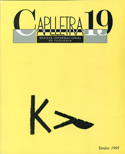Entonació i conversa: aproximació als mecanismes prosòdics demarcatius d'unitats sintàctiques en la parla col·loquial
DOI:
https://doi.org/10.7203/caplletra.19.7369Paraules clau:
fonologia, entoncació, conversa, prosòdia, sintaxi Resum
Resum
The purpose of this essay is basically informative; we are dealing with studies related to the prosody of spontaneous speech which are still not very well known in the world of Spanish linguistics (which includes Catalan linguistics). We offer a general state of affairs, and do not seek, therefore, to present the conclusions or results of any individual empirical study, but rather to point out some of the latest channels of investigation.
The criteria adopted in the exposition of authors and schools are chronological and epistemological, both of which overlap. Knowledge regarding the demarcative function of intonation has been perfected comparably to the development of linguistics; from the study of ideal and isolated units of sentence we go over to consider total units formed by elements of an inferior category (Sentence Functional Perspective), which leads us to the need to justify how enunciative contents are presented (School of Prague, English Systematics ...). Once we have transcended the frame of sentences and of the analysis of macro-units in oral language we are taken from the study of the demarcative mission of intonation inside a contribution, to denote the boundaries between contributions (turns).
368
We therefore find ourselves before discursive or interactive and conversational approaches (Schools of Edimburgh and Birmingham; I. Lehiste ...). Finally, it seems correct to defend the demarcative viewpoint in the hierarchical function of intonation, establishing boundaries between units in their different levels of linguistic expression (Phonological Hierarchy of Linguistic Units, Treach 1974).
 Descàrregues
Descàrregues
Descàrregues
Publicades
Com citar
-
Resum455
-
PDF200
Número
Secció
Llicència
L’autor o autora que adrece un treball a la redacció de Caplletra perquè siga publicat ha de ser la persona titular legítima dels drets d'explotació. La legitimació per a la publicació del treball ha d’incloure també les imatges, les taules, els gràfics i altres materials que puguen complementar el text, amb independència de si n'és l'autor o autora.
Copyright. Quan publica el treball en la revista, l'autor o autora cedeix a Caplletra. Revista Internacional de Filologia els drets d'explotació (reproducció, distribució i comunicació pública), tant per a l'edició impresa en paper com per a la versió electrònica, que serà accessible mitjançant la xarxa Internet.
Tots els treballs publicats en Caplletra es troben sota una llicència Creative Commons del tipus Reconeixement-NoComercial-SenseObraDerivada 4.0.
RESPONSABILITAT
Caplletra. Revista Internacional de Filologia no s'identifica necessàriament amb els punts de vista mantinguts en els treballs que publica.
Caplletra. Revista Internacional de Filologia declina tota responsabilitat derivada de qualsevol vulneració eventual dels drets de propietat intel·lectual que poguera ser duta a terme pels autors o autores.






